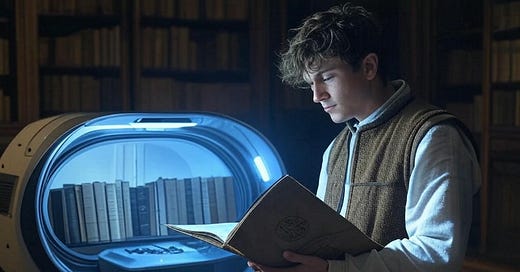After finishing the first draft of my novel and updating the outline with help from AI before tackling the second draft, I had an intriguing conversation with friends. One suggested using AI to analyze my manuscript by asking:
"How would you describe this author's writing style?"
"Which authors and books does this manuscript have most in common with and why?"
(Tip: You’ll get more genuine answers if the AI doesn't know you’re the author.)
As I mentioned in my last post, ChatGPT initially struggled to process the full 92,000-word draft, so I was especially curious about the insights these prompts would provide.
Admittedly, having extensively collaborated with GPT on refining my outline, I suspected the AI wouldn’t be fooled by this exercise and would know this was my manuscript. Although this suspicion was confirmed by some of its responses, it was a fun exercise that produced some helpful insights.
For starters, GPT described my writing style as:
“Imaginative, approachable, and richly descriptive, creating an immersive reading experience. The narrative blends speculative fiction, science fiction elements, and adventure seamlessly, driven by modern and futuristic technology intertwined with historical mysteries and archaeological exploration. Dialogue effectively reveals character relationships, maintaining a compelling balance between introspective narrative and dynamic action-driven pacing.”
I found this assessment flattering, as well as some of the descriptions in its “key characteristics of the author’s style"—particularly the praise for detailed world-building and engaging dialogue—but personally felt these were areas still needing substantial improvement. While I initially kept world-building somewhat minimal in the first draft to prioritize shaping the core narrative, I might have been overly critical in evaluating my first draft. It’s kind of hard to draw the line between my inner critic and GPT’s people-pleasing nature to know where the truth really lies, but it’s something I’ll file in the back of my mind for future reference. As part of my process to refine the outline, I spent a good bit of time developing the world-building and backstory to give the story the level of detail and authenticity I am striving for, so hopefully my inner critic will be satisfied with the updates, although I know complete satisfaction is a tall order.
Given my intention to steer this novel toward a young adult (YA) audience, I was encouraged when GPT compared my manuscript to titles such as:
James Rollins – Sigma Force Series
Madeleine L’Engle – A Wrinkle in Time
Rick Riordan – Percy Jackson & the Olympians, The Heroes of Olympus
Suzanne Collins – Gregor the Overlander (The Underland Chronicles)
Eoin Colfer – Artemis Fowl
I won’t pretend that my novel is anywhere in the same league as these, but perhaps it has the bones to eventually grow and develop into a story that can hold its weight in this class. More importantly, that it can be a story readers will truly enjoy. Obviously, that’s the goal, perhaps a somewhat elusive one, that all authors strive for.
Interestingly, I’m embarrassed to say, I haven’t read some of these books, so GPT inadvertently gave me some homework to do. I spent many years reading business, self-help, finance, and related books that I didn’t read a lot of fiction for a while, but I just finished reading Dune, so I’ll be doing some research as I make my way through this list, and other similar stories, to get an even better understanding of the storytelling techniques and elements that resonate with readers in the YA genre, particularly the corner of the genre that my story would potentially fit into.
Then, taking it a step further, the question I would have asked, although GPT already provided the answer for me, “Why these comparisons?” According to GPT:
“The manuscript strongly aligns with YA and speculative fiction authors who blend mystery, adventure, family dynamics, and elements of technology or history. Like these authors, your manuscript effectively balances character-driven storytelling with intriguing scientific and historical mysteries, making complex ideas both accessible and exciting for younger readers.”
These are certainly a lot of elements to juggle deftly, but it’s also good to know that my framework is on the right track and that I have a guidepost to work toward.
And, yes, to an extent, I do believe that GPT was flattering me a bit in its analysis, but I do feel that it was an insightful exercise that may be one you’ll want to try out on your own to see the type of feedback you get.
For me, this AI-driven analysis helped give positive reinforcement on areas that seemed in alignment with my storytelling goals while also helping clarify areas I should focus on as I take another step forward in refining my story to become the book I envision.




